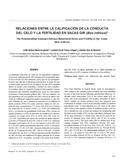Mostrar el registro sencillo del ítem
Relaciones entre la calificación de la conducta del celo y la fertilidad en vacas gir (Bos Indicus)
| dc.rights.license | http://creativecommons.org/licenses/by-nc-sa/3.0/ve/ | |
| dc.contributor.author | Ramírez I., Lílido N. | |
| dc.contributor.author | Torres, Leandro | |
| dc.contributor.author | Díaz de Ramírez, Adelina | |
| dc.date.accessioned | 2013-02-28T13:57:35Z | |
| dc.date.available | 2013-02-28T13:57:35Z | |
| dc.date.issued | 2012-12-31 | |
| dc.identifier.issn | 0798-2259 | |
| dc.identifier.uri | http://www.saber.ula.ve/handle/123456789/36672 | |
| dc.description.abstract | La deficiente detección de celos en las ganaderías tropicales como la de doble propósito (DP) basada en la aceptación quieta de la monta, ha sido señalada como uno de los principales factores que afectan la eficiencia reproductiva. A pesar de que la observación visual (OV) de los signos del celo (SC) continúa siendo la técnica más extendida y factible en estos rebaños, los estudios sobre la conducta sexual no han sugerido nuevas propuestas que permitan identificar las vacas en celo natural sometidas a inseminación artificial (IA). Con ese objetivo, en una ganadería DP con ganado Gir (Bos indicus) se aplicó una Tabla de calificación asignando puntos ponderados a cada SC para definirlas en celo y analizar su relación con la fertilidad al primer servicio (FPS). En cuatro períodos diarios de OV, durante 80 días, se detectaron 111 celos; sólo el 62,2% lo fueron por detección de la monta (VCM) y el 37,8% por calificación (VCC). La relación de probabilidad odds ratio (OR) o riesgo de quedar preñada y el 95% de intervalo de confianza (IC) fueron: conducta de monta (VCC 57% vs VCM 33%) OR: 2,26; IC: 1,21-5,87; aceptación por apoyo del mentón en grupa (Ausente 30,8% vs Presente 45,8%) OR: 0,52 IC: 0,20-1,33; conducta fisiológica (=30 puntos 32,7% vs >30 puntos 51,8%) OR: 0,45; IC: 0,20-097; monta desorientada (Ausente 43,5% vs Presente 36,8%; OR: 1,31; IC 0,47-3,65; conducta interactiva (=5 puntos 48,3% vs >5 puntos 40,2%); OR: 1,38 IC: 0,59-3,24. La fertilidad global fue del 42%. La Tabla propuesta permitió identificar un 38% de celos sin exhibición del signo principal de la monta logrando un 57% de preñez, es decir 2,26 veces más fértiles que las VCM. Un ajuste particular de la Tabla permitiría su aplicación en la DP y mejorar la fertilidad de los rebaños. | es_VE |
| dc.publisher | sa | es_VE |
| dc.rights | info:eu-repo/semantics/openAccess | |
| dc.subject | Signos celo | es_VE |
| dc.subject | Calificación | es_VE |
| dc.subject | Gir | es_VE |
| dc.subject | Anestro | es_VE |
| dc.subject | Fertilidad | es_VE |
| dc.title | Relaciones entre la calificación de la conducta del celo y la fertilidad en vacas gir (Bos Indicus) | es_VE |
| dc.title.alternative | The relationships between estrous behavioral score and fertility in gyr cows (Bos Indicus) | es_VE |
| dc.type | info:eu-repo/semantics/article | |
| dc.description.abstract1 | Poor heat detection in tropical herds, such as dual-purpose (DP), based in the standing heat mounting, has been identified as one of the main factors affecting reproductive efficiency. Although visual observation (VO) of the estrus signs (ES) remains the most widespread and feasible technique in these herds, studies on sexual behavior have not proposed new techniques to identify cows in heat naturally subject to artificial insemination (AI). To that objective, in a DP herd of Gir cattle (Bos indicus) was applied a table of weighted points score for ES to identify the cow in heat and analyze its relationship with the first service fertility (FSF). In four daily times during 80 days of VO were detected 111 estrus cows, only 62.2% were for detection of standing heat cows (SHC) and 37.8% by estrus score cows (ESC). The odds ratio (OR) or relative risk of becoming pregnant and 95% confidence interval (CI) were: mounting behavior (57% ES Cvs. SHC 33%) OR: 2.26 CI: 1.21 -5.87; chin resting received (Absent 30.8% vs. Present 45.8%) OR: 0.52; CI 0.20 to 1.33; physiological behavior (32.7%= 30 points vs. > 30 points 51.8%) OR 0.45, CI: 0.20 to 097; disoriented mounting (Absent 43.5% vs. Present 36.8%), OR 1.31, CI 0.47 to 3.65; interactive behavior (= 5 points 48.3%vs. > 5 points40.2%): OR: 1.38 CI: 0.59 to 3.24. The global fertility rate was 42%. The Table proposed make possible to identify a 38% of estrus without display standing heat achieving pregnancy by 57%, which means 2.26 times more fertile than the SHC. A particular setting of the table allows its application in DP and improves the fertility of the herds | es_VE |
| dc.description.colacion | 537-544 | es_VE |
| dc.description.email | lilidor@ula.ve | es_VE |
| dc.description.frecuencia | Bimestral | |
| dc.identifier.depositolegal | 199102ZU46 | |
| dc.publisher.pais | Venezuela | es_VE |
| dc.subject.institucion | Universidad del Zulia (LUZ) | es_VE |
| dc.subject.institucion | Universidad de Los Andes (ULA) | es_VE |
| dc.subject.keywords | Estrous signs | es_VE |
| dc.subject.keywords | Score | es_VE |
| dc.subject.keywords | Gyr | es_VE |
| dc.subject.keywords | Anestrus | es_VE |
| dc.subject.keywords | Fertility | es_VE |
| dc.subject.publicacionelectronica | Revista Científica | |
| dc.subject.seccion | Revista Científica: Producción Animal | es_VE |
| dc.subject.thematiccategory | Medio Ambiente | es_VE |
| dc.subject.tipo | Revistas | es_VE |
| dc.type.media | Texto | es_VE |
Ficheros en el ítem
Este ítem aparece en la(s) siguiente(s) colección(ones)
-
Revista Científica - 2012- Vol. XXII - No. 006
Noviembre - Diciembre 2012


